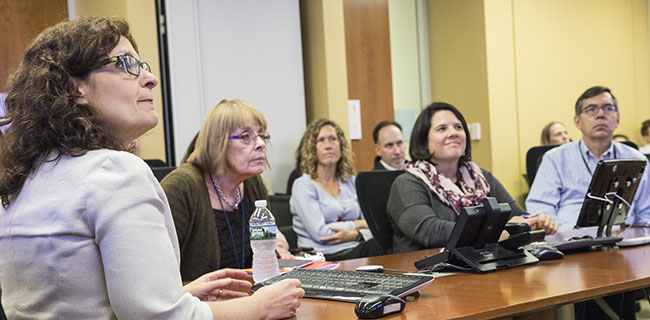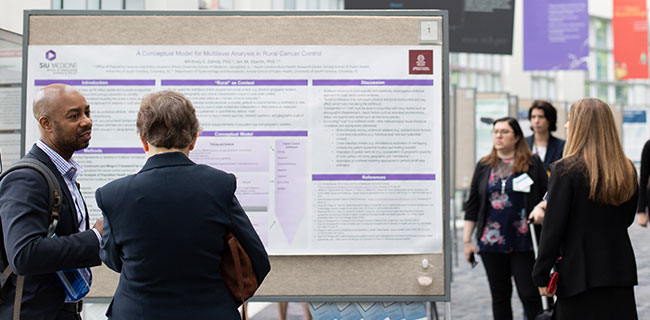Priority Research Efforts
DCCPS-funded research focuses on defining factors that influence cancer risk and prognosis, as well as integrating evidence-based interventions into practice and tracking outcomes. Cancer outcomes research has expanded to include not only traditional biomedical outcomes, but also health-related quality of life, patient experiences of care, and economic burden. Researchers are examining variations in the patterns and quality of cancer care. They also are exploring the use of precision tools to measure factors affecting health disparities and to develop targeted interventions for both large populations and individual patients.
Expanding Smoking Cessation Services
at NCI-Designated Cancer Centers
Smoking rates have decreased substantially in the United States over the past several decades; however, too many smokers who are diagnosed with cancer don’t quit smoking. Continued smoking after a cancer diagnosis can interfere with treatment and worsen a patient’s prognosis, while quitting can help improve patients’ symptoms and their ability to recover more quickly from treatment, in addition to improving their long-term outcomes.

To help address this issue, and in response to the Cancer Moonshot Blue Ribbon Panel recommendation to better understand how to implement and sustain comprehensive tobacco control strategies among patients using existing health-related infrastructure, NCI launched the Cancer Center Cessation Initiative.
Using Cancer Moonshot funds, the initiative provided resources in FY17 and FY18 to 42 NCI-Designated Cancer Centers to expand existing efforts intended to help their patients who are smokers to stop smoking. Centers will endeavor to identify and offer evidence-based cessation treatment to all cancer patients who smoke. They are also required to sustain these interventions for a minimum of 3 years after the funding ends.
Ultimately, the goal is to more fully integrate cessation interventions into routine patient care at cancer centers, so that helping cancer patients who smoke to quit becomes the standard of care in cancer treatment. NCI’s expectation is that centers that received these awards will substantially expand their delivery of cessation services and will sustain those services into the future. It is also hoped that these centers can share the lessons learned from their experience to provide guidance to cancer centers and to other hospitals to help more patients quit smoking.
Adapted from NCI’s Cancer Currents Blog, November 22, 2017.
Enhancements to NCI’s SEER Program
Creating New Research Opportunities
Since its launch 45 years ago, NCI’s Surveillance, Epidemiology, and End Results (SEER) Program has been the nation’s premier source for clinically relevant patient data at the population level—data that the research community, as well as patients, want and need to better understand cancer and its impact. One of NCI’s most important partnerships with the Centers for Disease Control and Prevention, the SEER Program is the most comprehensive population-based cancer registry in the world and is an invaluable resource for conducting population-based observational studies, as well as clinical and even basic research.

In FY18, after a lengthy and complex re-competition process, DCCPS awarded contracts to the SEER Program registries. The new Program includes 16 registries covering 34% of the population and 19 different geographic areas, and is valued at more than $40 million per year. Also in recent years, DCCPS and SEER leadership have been working with many groups and experts to better understand the cancer research community’s needs and the opportunities that could be created through strategic, targeted enhancements to SEER.
In those discussions and forums, the main data needs that were identified included those that cover
- All treatments received by individual patients from diagnosis until their death;
- Outcomes other than incidence and mortality—in particular, recurrences; and
- The genomic composition of patients’ tumors.
As might be expected, enabling SEER to collect such data, and ensuring that they are accurate, is an extremely complex undertaking. It’s because of that great complexity that NCI is moving forward with these enhancements in a thoughtful and systematic way—one that we believe will lay the foundation for successfully integrating them into the broader SEER Program.
Among the most important enhancements to the SEER Program is the expansion of the size and diversity of the population it covers. With the expansion in FY18, SEER is now collecting data on approximately 550,000 new individual cancer cases each year. This expansion was implemented with a strategic focus: adding US cancer registries that include more underserved and ethnic/racial minorities, in order to capture cancer data that more fully represent the US population.
Unfortunately, we can’t immediately start collecting every type of data we’d like SEER-wide. Therefore, the Program has also launched a series of pilot studies that can help us better understand the barriers and challenges to collecting these new types of data.
For example, as mentioned previously, NCI is partnering with Department of Energy (DOE) scientists, using funding provided through the Cancer Moonshot, to develop tools that will allow SEER to collect the data elements it has traditionally captured (e.g., cancer type and grade), as well as new data elements (e.g., biomarkers, recurrences), from patient medical records. Compared with the manual collection that is often used now, automated data collection would be far more reliable and rapid, even if some cases still require manual coding. Another SEER pilot study is focusing on collecting data on the use of oral cancer drugs and adherence to prescribed regimens by linking registry data with pharmacy data. Similar pilot efforts are creating linkages between SEER registries and health insurance claims data from some of the largest health insurance companies in the country. Other pilot linkage efforts under way involve collecting data on the results of genomic tests. As oncology continues on the road to precision medicine, the ability to systematically collect these data would go a long way toward informing this movement.
While these linkage pilots are noteworthy, another exciting enhancement to SEER under active evaluation is on the other end of the research spectrum: the development of a “virtual biorepository.” The aim of this repository is to provide information on tumor samples stored at institutions across the country. This will allow investigators to search for samples from patients with certain demographic or clinical characteristics or certain outcomes, and then request those samples (including all related clinical data on that patient) via an honest broker for use in their research.
Over the coming decade, stay tuned to hear more about a remarkable array of new scientific opportunities. As always, DCCPS welcomes ideas and feedback from the cancer community about ways to strengthen the utility and usability of SEER data for both cancer research and cancer control planning.
Adapted from NCI’s Cancer Currents Blog, August 23, 2018.
Research to Improve Cancer Control
in Rural Communities
In addition to higher poverty rates and lower educational attainment, rural communities face numerous challenges compared to urban areas. Rural communities have higher average death rates from cancer for all cancer sites combined, higher incidence and death rates for cancers associated with smoking (e.g., lung and laryngeal cancers), and higher rates of colorectal and cervical cancers—cancers that can be prevented by screening. And although death rates from cancer are decreasing in both rural and urban areas, they are decreasing much more slowly in rural areas, further compounding these cancer disparities.

Research has shown that some of these cancer disparities can be attributed to financial barriers and barriers to health services, such as no or insufficient insurance coverage, transportation issues, and lack of preventive and screening services. There are also rural-urban differences in behaviors that are associated with cancer, including higher rates of tobacco use, alcohol consumption, and obesity; and lower rates of physical activity, adoption of sun safety measures, and HPV vaccination rates in rural compared to urban areas.
This long-standing public health challenge calls for sustained support for research along the entire cancer control continuum, with interdisciplinary cross-sectional collaborations. This past year, DCCPS awarded 21 administrative supplements to P30 Cancer Center Support Grants to develop rural cancer control capacity. These supplements will provide resources to support the time and effort of teams at NCI-Designated Cancer Centers, in collaboration with rural communities and clinics, who will develop a comprehensive rural cancer control program that serves low-income and underserved populations. Seven of these awarded supplements focus on Native American populations.
Initial analysis of broadband and cancer data has shown that rural “cancer hotspots” are areas that also face large gaps in broadband access and adoption, which put care solutions out of reach for many. Therefore, DCCPS joined forces with the Federal Communications Commission to increase broadband access and adoption in rural areas to improve the lives of rural cancer patients. The project—titled LAUNCH (Linking & Amplifying User-Centered Networks through Connected Health): A Demonstration of Broadband- Enabled Health for Rural Populations in Appalachia—will target areas that face the dual challenge of higher cancer mortality rates and lower levels of broadband access. The initial geographic focus is planned for rural Kentucky. The LAUNCH demonstration project links recommendations from the President’s Cancer Panel’s 2016 report (Improving Cancer-Related Outcomes with Connected Health) with selected targets of opportunity from the Cancer Moonshot Blue Ribbon Panel 2016 Report.
DCCPS also spearheaded a meeting in May 2018 that brought together more than 250 researchers, clinicians, and agency and community partners from a wide range of backgrounds and expertise to address rural health disparities. That meeting and its resulting discussions and partnerships—along with a new funding opportunity, Improving the Reach and Quality of Cancer Care in Rural Populations, which will be awarded in FY19 for approximately $35M over 5 years—will spur more research in this domain to improve the reach and quality of cancer care in rural populations. Focused research initiatives will provide the groundwork to develop and implement cancer control programs that are sustainable in these rural communities across the United States.
Health Care
Delivery Research
Health care delivery research at NCI incorporates the study of cancer care, factors influencing care, and outcomes of care. Cancer care refers to medical services offered across the cancer continuum, such as screening individuals not known to have cancer; treating cancer patients; following cancer survivors for recurrence; and providing psychosocial support at the end of life for patients and their caregivers. Ultimately, the outcome of most interest in health care delivery research is reducing the burden of cancer on individuals and society.

DCCPS’ Healthcare Delivery Research Program leads the Cancer Care Delivery Research (CCDR) area of NCI’s Community Oncology Research Program (NCORP). NCORP is a national network that brings cancer prevention clinical trials and cancer care delivery research to people in their communities. The CCDR portion specifically examines how social factors, financing systems, organizational structures and processes, health technologies, and health care provider and individual behaviors affect cancer outcomes, access to and quality of care, cancer care costs, and the health and well-being of cancer patients and survivors. NCORP clinical trials and research studies are under way at sites throughout the country. The network’s research bases are “hubs” for the network that design and spearhead the conduct of multicenter clinical trials.
Another network supported by DCCPS’ Healthcare Delivery Research Program is the Population-based Research Optimizing Screening through Personalized Regimens (PROSPR) initiative, which focuses on the challenges and processes of cancer screening for breast, colon, and cervical cancers in community settings. For the second PROSPR funding cycle, which started in April 2018, NCI funded one coordinating center and three research centers (one each focused on cervical, colorectal, and lung cancer). Each research center includes a minimum of three heterogeneous health care systems with diverse patient populations. The overall goal of PROSPR is to enhance understanding of the implementation and effects of screening as practiced in multiple health care environments in the United States. In addition to conducting multilevel observational research to evaluate factors that affect the quality of the screening process for the selected cancer type, the research centers will develop and pilot-test interventions aimed at improving the screening process for that cancer. PROSPR’s publicly available data set can be used in research to understand the long-term consequences of screening and provide a basis for interventions.
Understanding and Addressing
the Needs of Cancer Survivors
As of January 2019, it is estimated that there are 16.9 million cancer survivors in the United States, and this number is projected to grow to over 26 million survivors by 2040. These numbers underscore the growing importance of better understanding the needs of cancer survivors and how best to care for those survivors. Childhood cancer survivors, in particular, have unique needs, with two thirds of childhood cancer survivors suffering from at least one health problem caused from their treatment. Beyond physical health issues, childhood and adolescent and young adult (AYA) survivors have unique challenges in health care delivery (e.g., unmet needs for long-term follow-up, issues with continuity of care) and are at increased risk for a myriad of psychosocial and behavioral adverse effects. The number of childhood cancer survivors continues to grow, as well. In the latest published data at this time, there were approximately 429,000 survivors of childhood and adolescent cancer in the United States. That number will continue to increase, given that the incidence of childhood cancer has been rising slightly in recent decades and that survival rates overall are improving.

In May 2018, Congress passed The Childhood Cancer Survivorship, Treatment, Access and Research (STAR) Act, developed in collaboration with many childhood cancer organizations as a comprehensive childhood cancer bill to advance pediatric and AYA cancer research and treatments, improve cancer surveillance, and enhance resources for survivors and their families. The STAR Act authorizes improvements to biospecimen collection and associated infrastructure, registry infrastructure, and research to improve the care and quality of life for cancer survivors – including children and AYAs.
DCCPS has issued a funding opportunity announcement to efficiently implement major elements of the STAR Act by funding multiple intervention research project grants beginning in FY19. This Cancer Moonshot research funding announcement (RFA) focuses on stimulating the scientific development of effective, feasible, and scalable interventions to address biomedical, behavioral, and psychosocial adverse effects in survivors of pediatric/AYA cancers. This RFA requests applications from investigators to address the areas of research outlined in the STAR Act by proposing intervention studies to improve health care delivery or to prevent or mitigate adverse effects in pediatric/AYA cancer survivors. The development of interventions to address health disparities and the needs and preferences of minority or other medically underserved populations will be of high priority in all research areas.
DCCPS has also proposed an RFA focused on survivors of adult-onset cancers. This Cancer Moonshot RFA, which will be funded in FY20, is designed to stimulate interventional research aimed at enhancing communication, engagement, and coordination between oncology specialists and providers not involved in active cancer treatment, in order to optimize follow-up care for cancer survivors. It is expected that the ability to care for the growing number of survivors will be advanced by demonstrating how other types of care providers can be engaged in coordinated survivorship care, thereby conserving scarce specialized resources for those in need of more intense, cancer-focused care. Accordingly, this RFA has the potential to change the face of cancer survivorship care.

